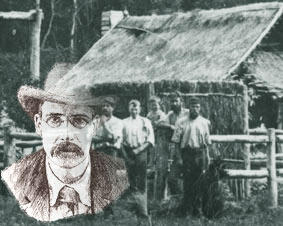William Lane's utopian dream of 'New Australia'

 1861 William Lane (d. August 26, 1917), pioneer of the Australian Labor movement, and certainly its most famous leader and newspaper editor in the 1890s. He is best remembered today for leading a large proportion of Australian labor activists and many working class people to found a utopian colony in Paraguay. The colony struggled for some years, but eventually failed and Lane became a conservative newspaper editor in New Zealand.
1861 William Lane (d. August 26, 1917), pioneer of the Australian Labor movement, and certainly its most famous leader and newspaper editor in the 1890s. He is best remembered today for leading a large proportion of Australian labor activists and many working class people to found a utopian colony in Paraguay. The colony struggled for some years, but eventually failed and Lane became a conservative newspaper editor in New Zealand. Before Australia, Lane had been a newspaperman in the USA but was born in Bristol, England, and died in Auckland, New Zealand. In 1885, aged 24, after having worked in the US and Canada, he immigrated to Australia and worked in Brisbane as a journalist, eventually becoming editor of the Worker and publishing, among others, Henry Lawson, Australia's national poet, who worked under him from March-September, 1891 in Brisbane on the radical Boomerang newspaper.
In the USA Lane had worked first as a printer, then as a reporter for the Detroit Free Press (1881). In Brisbane he worked on the Courier and Evening Observer until, in 1887, he established his own weekly labor paper, the Boomerang, soon becoming a power in Queensland labour politics. He was also a supporter of Emma Miller and the Women's suffrage movement, and a strong proponent of Henry George's Single Tax Movement, very popular in Australian following George's 3-month tour. Lane was also influenced by writings on Lemuria, Shangri-la and Utopia, and the utopian writings of Edward Bellamy and writings and experiments of Etienne Cabet. A smallish man with gold-rimmed spectacles, a club foot and walking stick, he seemed an unprepossessing and unlikely character to become a major labour leader, but that is exactly what happened ...
In 1892 Lane (as 'John Miller') wrote a novel, The Working-man's Paradise. Mary Gilmore later wrote in one of her letters "the whole book is true and of historical value as Lane transcribed our conversations as well as those of others"; both she and Henry Lawson were characters under other names, he being 'Artie', according to Gilmore, although this is disputed by some. Perhaps even before the novel Lane had it in mind to establish an intentional community (it might be that the novel was written to promote the idea, or at least to sow the seeds). Alf Walker, William Saunders and Charles Leck went to Paraguay and negotiated a land grant with the government – 450,000 acres on the Tebicuari River, about 20 miles from Villa Rica in eastern Paraguay, an old Spanish colonial town, the largest in the country's interior, 70 miles north-west of the capital, Asunción.
Following many delays, and obstructions set in train by the conservative Dibbs Government, the 598-ton Royal Tar, purchased for 1,350 pounds and refitted, Mort Bay in Sydney on July 17 (some sources say July 16), 1893 bearing 220 men, women and children, the advance party of those who would "write the history of humanity on the rocks of the Andes", arriving at Montevideo on September 13, and he worked hard to establish the New Australia utopian communist settlement (he called it "socialism with a small 's'"). From the time the first idealistic people set sail for New Australia, Lane's writings consistently insisted that there was no other way for socialism to be reached in the lifetime of the Australian worker. Hundreds of workers believed him. Lane was no fringe lunatic, but one of the country's best-known labour leaders. By today's standards it may be likened to one of the best known Australian Labor Party politicians inspiring thousands of workers to pack up and sail for South America – or the Moon ...
Categories: australia, utopia, utopian, communism, communist, socialism, socialist, intentional, community, commune, communes, paraguay, australian, henry, lawson, mary, gilmore, history







0 Comments:
Post a Comment
<< Home